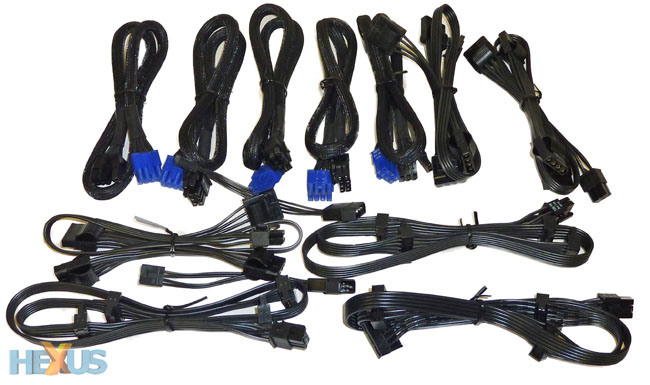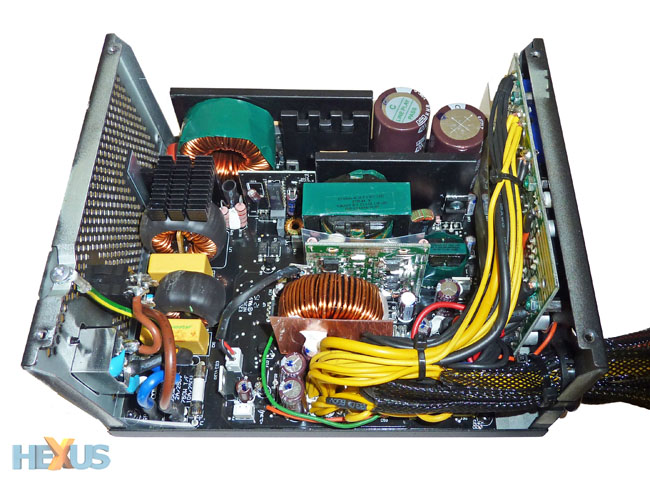Cables, and a look inside
| Cables | Cables, type, length, plugs on cable | |||||||
|---|---|---|---|---|---|---|---|---|
| Main | 20+4-pin (61cm) - attached | |||||||
| ATX/EPS | P4+P4 (65cm) - attached | ATX/EPS 2 | P4+P4 (65cm) - modular | |||||
| PCIe 1 | 6+2 (60cm) x2 - attached | |||||||
| PCIe 2 | 6+2 (60cm) x1 - modular | PCIe 3 | 6+2 (60cm) x1 - modular | |||||
| PCIe 4 | 6+2 (60cm) x1 - modular | |||||||
| PCIe 5 | 6+2 (60cm) x1 - modular | |||||||
| Peripheral 1 | SATA (70cm) x4 - modular | |||||||
| Peripheral 2 | SATA (70cm) x4 - modular | |||||||
| Peripheral 3 | SATA (85cm) x4 - modular | |||||||
| Peripheral 4 | Molex (75cm) x 4 - modular | Peripheral 5 | Molex (75cm) x 4 + floppy - modular | |||||
| Peripheral 6 | Molex (75cm) x 4 + floppy - modular | |||||||
And Corsair provides the proverbial kitchen sink. The package includes four further PCIe (PEG) cables with a 6+2-pin on each, a second EPS12V 8-pin connector - not present in the original HX850 - for power-hungry motherboards, 12 SATA and 12 Molex, split with three connectors on each cable, and, finally, a couple of Molex-to-floppy adapters.
Look back to how the modular connectors are plumbed out and you could take up the four blue-coloured ports with the four bundled (blue-headed) cables, providing a total of six 6+2-pin connectors for three high-powered graphics cards. The six peripheral connectors - 12 SATA and 12 Molex - can also be connected straight to the supply. Corsair's cabling and port arrangement is, in a word, excellent, and the only method by which all supplied cables cannot concurrently be used is if you need to also connect the second EPS on top of the six PEGs. Got all that?
But this review is more about determining what's new about this HX850 revision than eulogising about class-leading cabling. Carrying on from the strategy adopted with the second revision of the Gaming Series GS800 supply, the HX850W's fan, also manufactured by Ong Hua, doesn't spin up until there's a 20 per cent load on the PSU. Putting it another, more digestible way, the supply has no active cooling until tasked to provide around 170W to the system. After this point the speed and noise increase gradually, achieving mid-noise levels at around 70 per cent load.
Readers familiar with the inner working of a PSU will recognise CWT's design almost immediately. The foundation is similar to the GS800's, but this time the supply is rated as 80 PLUS Gold. This means that it has to be at least 88 per cent efficient at 20 per cent and 100 per cent loads, respectively, while at 50 per cent load the supply must have an efficiency metric of at least 92 per cent, and it must do all of this while potentially running at high ambient temperatures.
In case you don't know, being 92 per cent efficient means that delivering, say, 425W DC to the components - or 50 per cent load - has to be done by drawing no more than 462W of AC power at the wall. The higher the efficiency, the closer the at-wall AC and DC-delivering numbers. High-efficiency supplies tend to produce less heat, which is wasted energy, so cooling should be easier.
Initial EMI filtering is taken care of by two Y-type capacitors - right by the power inlet - and then augmented by a further two hidden behind the larger X-type caps. Continuing the EMI suppression and often seen in most mid-range PSU, a couple of common-mode chokes are standard fare, and a metal-oxide varistor (MOV) is present just below the first X-type cap. The similarities with the GS800 don't end there, as this supply has a single rectifier - used to convert AC to DC - and, as far as we can tell, the same active PFC and booster.
With the power now rectified and boosted the next step is to store it for the PSU to dish out. The HX850 uses two Nippon Chemi-Con caps rated at 300uF and 420V at 105°C; they're amongst the best in the industry so no complaints here. Being a DC-to-DC supply the HX850 derives the 3.3V and 5V lines from the 12V and using this approach enables high efficiencies to be attained. Looking down towards the secondary side, the HX850 also uses the same capacitors as on the GS800 - notice a pattern here? Lastly, soldering is reasonable-to-good throughout the PSU.
Amps/watts and voltage |
3.3V |
5V |
12V1 |
-12V |
-5VSB |
|||
|---|---|---|---|---|---|---|---|---|
Rail amps |
25A |
25A |
70A |
0.8A |
3A |
|||
Maximum rating |
150W |
840W |
9.6W |
15W |
||||
Maximum rating continuous |
850W |
|||||||
Power-wise, the single 12V rail can be loaded with up to 70A, dished out over a few graphics cards and a high-end CPU. A combined 150W is just what we'd expect to see for masses of peripherals. Corsair can have almost all of the continuous capacity allocated to the single 12V line as there's no need to siphon off power on the initial DC side for the 5V and 3.3V lines; all three lines come from the 12V. The power distribution is sensible and in-line with Corsair's previous 850W supplies.
This modular-connected HX850, released three years after the original model, improves upon its forebear by offering a silent fan at up to 20 per cent load and an updated internal platform from CWT. The design borrows liberally from other modern Corsair PSUs, but that's no bad thing. Let's load it up and see how it performs.











